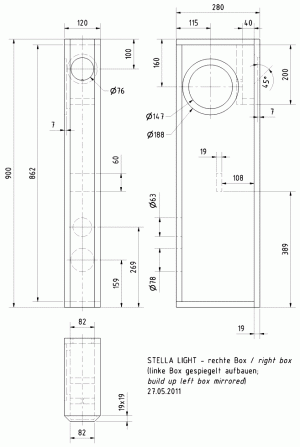STELLA LIGHT
Building instruction
Exploded drawing
Assembly
Building the cabinet is fairly easy because all the panels are glued together as butt joints. We recommend beginning with the rear wall to which you then attach a side wall, lid and base by gluing them in place. This is followed by the strengthening struts and chamber for the small full-range driver. Not until you have done this can you position the second side wall and glue it in place. All the openings except the one for the full-range driver in the front panel should be cut and routed later.
The opening for the full-range driver is a tricky one and requires very accurate cutting. To ensure the diameter is as accurate as possible, it makes sense to buy a hole saw of exactly the right size. Then, apply a bevel to the rear of the full-range driver opening using an angle router with a guide wheel or a simple rasp. To ensure that the driver is seated perfectly flush, the front edge should be slightly bevelled with a file or round router.
Once this is finished, you can glue the front panel to the body of the cabinet and then drill, cut and rout the openings for the woofer, bass reflex tube, terminals and cables (D = 8 mm). The bevels on the front panel are done last using an angle router or rasp. The hole for the cables in the full-range driver cabinet should be sealed later with hot-melt glue or a similar substance.
Stability can be improved by fitting a larger base board (e.g. 19 x 230 x 330 mm (h x b x d)) whose design can be freely varied.
The crossover connection is to be found under the following link:
Mounting guide crossover STELLA LIGHT (PDF; 674 KB)
Inner damping
Distribute the mats of damping material loosely throughout the cabinet. One quarter of a mat is required for damping the mid-range chamber and the rest for the bass area. Ensure the opening of the bass reflex tube is left free.
Cabinet parts list for 1 box
Sketch
Crossover
Press
“We ran the listening test in our listening room (as usual), which we felt was pretty unfair since we were sure the floor area would be far too big for the narrow Stella Light. Think again: These two 17-litre cabinets produce powerful bass full of low-frequency energy – not the slightest bit intrusive or booming, but, thanks to the high-quality paper diaphragms, filled with special lively elegance which, in my opinion, represents the ideal compromise between the two extremes of the crisp clarity of hard cones and the comforting warmth of plastic diaphragms, while radiating a maximum charm. Whenever one felt lulled into a state of comfortableness by the light-footed effortlessly capable W 170 S, suddenly a bass punch would be projected towards the listening position to remind us that this is, indeed, an ambitious driver with considerable surface area. In a smaller listening room, the bass loses nothing of its presence – the very idea of adding a sub-subwoofer is blasted into insignificance by these two speakers. Add to this lively bass the congenial FRS 8. This driver, unencumbered by the really low bass, demonstrates its dynamic, responsive character, and unfolds a range and depth of sound colour that covers nearly seven octaves and, once again, shows why it is one of the really big players among the small full-rangedrivers.
Conclusion
Not really “light”: 180 euros for two column speaker sets that are, in terms of their sound reproduction quality, fully grown-up – you can hardly beat that. And on top of it all there's a considerable portion of the fascination of full-range speakers – what more could one want?”


